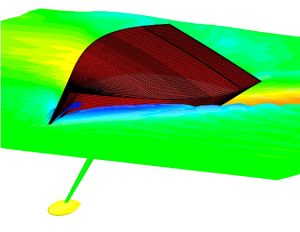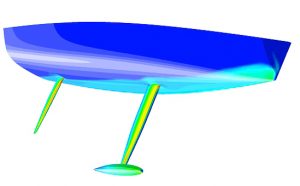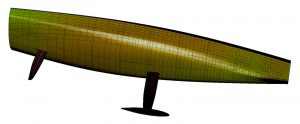Umberto Felci tells the secrets of the perfect hull
What are the characteristics of your hulls?
A good hull doesn’t come about by chance. It’s definitely the result of an in-depth knowledge of all the elements that make up the complexity of a sailing boat’s design.
In-depth hydrodynamic studies are the basis, but in addition to these, there are also accessory elements that are considered and evaluated when building a hull and that determine its effectiveness and success.
We have often 
But how do you achieve this balance? It certainly starts with the most important element of the boat, the hull.
If you were only looking for performance, or only for internal habitability, it might be somewhat easier.
In the sense that, in neither case, are there conflicting elements, which tend to “mitigate” each other, as happens in our fast-cruiser hull for example.
In fact, we start from the axiom that, in order to sail well, the salient characteristic of an “ideal” hull is certainly that of having the least possible drag and that, in order to be comfortable inside, it must allow for adequate volumes. In a cruising boat, for example, which must be able to perform both tasks in the best possible way, the least drag is to be found both in the least wetted surface, associated with a correct form stability, and in the least wave resistance, associated with an adequate volume.
These are important features, the balance of which is difficult to achieve but which nonetheless determine their effectiveness.
They are difficult precisely because there are so many elements to evaluate in a cruising boat.
An ideal hull should, for example, have the “capacity” to remain as efficient as possible, even and above all as the load conditions change. This characteristic is obviously not necessary in a hull that is designed exclusively for racing because its weight, under operating conditions, will always be the same.
On the other hand, in a cruising boat these conditions vary, and a lot. Between a weight in “light” trim, i.e. substantially with the boat empty and unloaded, and one “fully loaded”, i.e. with liquids and the normal equipment necessary for cruising, there can be a difference of up to 20%.

In order to find the right ratio between wetted surface area and form stability in a racing boat, this ratio must be associated only with the power offered by the sail area; weight is not a variable.
On the other hand, in a cruising boat weight variation becomes a very important factor.
As the weight increases, the volume immersed obviously increases and, consequently, so does the wetted surface area. The ratio with which this increases in relation to the increase in volume is one of the key elements, to be studied and resolved, and is directly linked to the shape of canoe body.
As the volume increases, a very flat hull will have a much greater increase in wetted surface area than a more rounded hull and this could have an important negative impact on the hull performance in light wind conditions. However, it should also be considered that a flat hull will be associated with greater form stability, resulting in a lower angle of balance for the same power, and this is generally considered positive in a cruiser.
Here is an example of how the same hull can have both favourable and unfavourable elements for good sailing performance.
In order to determine the correct ‘response’, it is necessary to carry out an extremely thorough study of all the actual construction weights and the centers of gravity of all the elements.
Further complicating matters is the fact that the ‘extra’ loads often have non-barycentric positions and so, as well as increasing the overall weight of the yacht, a change in longitudinal ‘trim’ must also be dealt with. This, too, must be managed by working on suitable hull shapes to minimize this negative impact.
To give a practical example, if I imagine a boat that in a light trim, is characterized by a stern at water level, with an increase in weight and a change in its longitudinal trim, I can expect a more negative impact than on a hull with a greater exit angle, i.e. with a stern that is further away from the waterline.
These, as well as many other elements, if properly managed and calculated, contribute to the production of the ‘right’ hull, with the appropriate volume and the center of thrust positioned at the correct point (the so-called Longitudinal Centre of Buoyancy).
Only a hull made like this is the one that allows you to enjoy sailing, to have the right trim both under sail and motor, to have a reduced pitch, a smooth passage on the wave and a limited roll at the mooring, to enjoy your holiday and sailing experience. A hull designed to have predictable, controlled reactions at all times and which, at the helm, gives the right feeling of control, being high performance but never excessive, even in the hardest conditions.
In short, after many years of experience in dealing with these problems, which are repeated in a very similar way on different yachts, in more or less obvious ways, we have developed procedures that allow us not to make mistakes and to always provide the yard or the owner with the best possible hull.
This is not a kow-how that can be improvised and I am absolutely convinced of how these analyses and requirements make a cruiser or fast cruiser hull as much and perhaps more complex to design than that of a pure racer. As in almost all the choices to be made in a project, an advantage corresponds to an equal and opposite disadvantage. Only by fully understanding these characteristics, and having the tools to evaluate the real ” importance ” of the effects that the different choices imply, will it be possible to find the right relationship between all the elements in play.
Basically, n hulls for n set-ups must be studied and all of them validated, working within ranges that can be considered valid. In an initial phase, these ranges are analysed by defining the main parameters of the hulls and the relative dimensional ratios and then, in a more advanced phase, the CFD analysis.
However, the fact remains that extremely sophisticated and effective tools, such as those offered by a CFD analysis, which has practically replaced the naval tank, cannot alone provide the answer to this type of problem.
Only direct knowledge of the problems and the effects of the choices made will make it possible to give the right shape to the hull, which can then be assessed and further optimized in virtual mode.
From my point of view, this is the DNA of every project and every designer. By analyzing the various shapes, you can understand the reasons behind them and it’s a very interesting exercise. It is also very interesting to evaluate the results over the years.
A good cruising boat, fast and comfortable, the result of a good design, remains so for years, an important evaluation, to be considered together with the elements that determine the purchase.































2 Responses
There is yet a discovery which the industry is not yet privileged to know, because our invitations are being ignored by the companies we email to.
Here, in this article, “big claims” are posted for getting attention to “no news” technologies claimed as if these are the best there is – yet, our actually new and original discovery innovated as most advanced hulls yet, is significantly different and very advantageous, but it is not offered for the risks from unlicensed copycats and reverse engineers or blunt IP pirates — which is why modern wisdom calls for us to partner first with a suitable existing major corporation in the industry – and as long as our invitations are being ignored by the arrogance of the industry to respect inventors, we are not ready for bringing to the industry our add-on-to hull the FPFINS product-line and advanced Superior Hulls’ design.
Lots of modern production boats seem to use form stability to excess. Wide transom and flat bottoms make them slow in light winds and they roll badly at anchor. They don’t take weight well when loaded up for liveaboard life and seem to have more beds than you need but not enough storage. Small water tanks, small fuel tanks and small engines with horrible sail drives. Cheap and unappealing boats for the masses